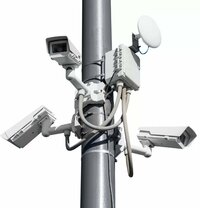
How to Choose the Right CCTV Camera Mast for Your Location
Choosing the right CCTV camera mast is crucial for optimal security and reliable surveillance footage. In this guide, you’ll learn step by step how to select between a fixed CCTV pole or a tilt-over camera mast, which material (aluminum or steel) is most suitable, and what factors such as height, wind load, and maintenance you need to consider.Want to explore our range right away? View our complete camera mast assortment and request a free quotation today.
Why Choosing the Right Camera Mast Matters
A well-selected security camera mast ensures:- a stable mounting position (less vibration, sharper image),
- the correct viewing angle and height for optimal coverage,
- easier installation and maintenance (especially with tilt-over masts),
- a longer lifespan and lower total cost of ownership (material choice: aluminum vs. steel).
Step 1 — Define Application and Location
Before selecting the material or mast height, determine the purpose and location:- Parking lot / business premises: typically fixed camera poles of 3–8 m for clear overview and license plate recognition.
- Construction site / temporary surveillance: tilt-over or telescopic camera masts for quick access and flexible deployment.
- Port / industrial sites: corrosion-resistant solutions (hard anodized aluminum or hot-dip galvanized steel) with taller masts for wide-area coverage.
Step 2 — Fixed or Tilt-Over Camera Mast?
Fixed camera mast
- Advantages: maximum stability, suitable for permanent installations and heavy CCTV equipment.
- Disadvantages: maintenance or replacement often requires a lift or crane.
Tilt-over camera mast (tiltable CCTV pole)
- Advantages: cameras can be inspected or replaced from the ground, reducing maintenance costs, ideal for locations requiring frequent access.
- Disadvantages: slightly more complex design and sometimes lower load capacity compared to heavy-duty fixed masts.
Step 3 — Aluminum or Steel Camera Mast
Hard anodized aluminum
- Long lifespan (50+ years), lightweight, low-maintenance, available in various anodized finishes.
- Perfect for coastal areas and environments with high corrosion risk.
Hot-dip galvanized steel
- Strong, durable, and capable of supporting heavy CCTV cameras in extreme conditions.
- Expected lifespan 30+ years; can be powder-coated in any RAL color for aesthetics.
Step 4 — Height, Wind Load, and Mounting Specifications
- Height: consider sight lines, obstacles, and privacy regulations. For license plate recognition, 3–6 m is often sufficient; for wide-area surveillance, 8–12 m is common.
- Wind load: taller masts face higher wind pressure; select a mast with the correct wind load class or opt for a robust steel version.
- Foundation & mounting: ensure the foundation and anchor materials are designed for the mast height and combined camera weight.
Practical Checklist
- Purpose of surveillance (entrance, license plate recognition, perimeter security)
- Fixed or tilt-over mast required?
- Material: hard anodized aluminum or galvanized steel?
- Height and wind load calculated?
- Foundation and cable routing arranged?
- Finish: powder coating (RAL) or anodization?
- Professional installation and maintenance needed?
Accessories and Options for CCTV Poles
Our camera masts can be expanded with:- Climb-prevention systems
- Camera brackets / mounting arms
- Lockable junction box for wiring
- Concrete base for installation
- Powder-coated or anodized finish in various colors